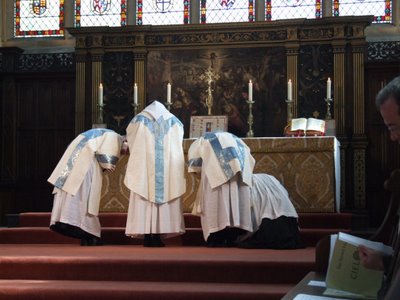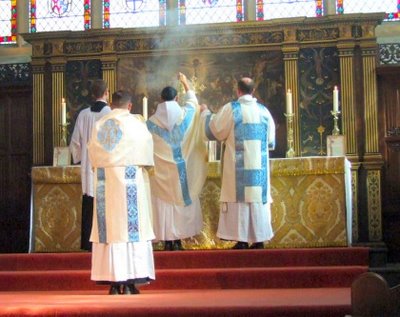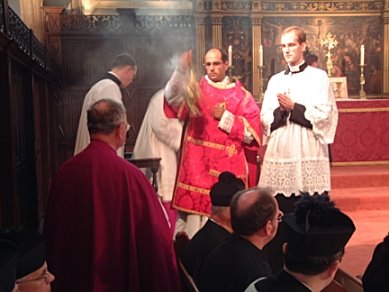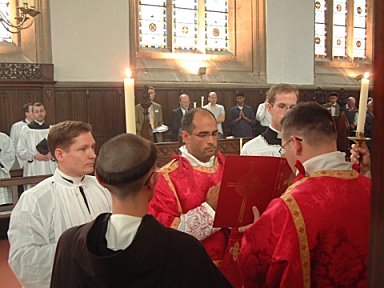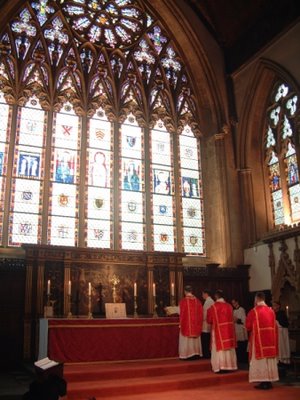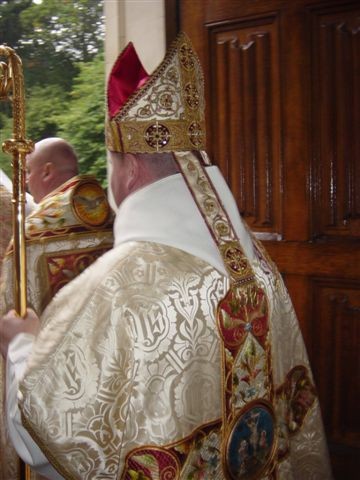From our friends at
Whispers in the Loggia:
VOX CLARA COMMITTEEPRESS RELEASE
October 27, 2006
The Vox Clara Committee met for the tenth time from October 23-26, 2006 in the offices of the Congregation for Divine Worship and the Discipline of the Sacraments in Rome.Since its establishment by the Congregation on July 19, 2001, this Committee of senior Bishops from Episcopal Conferences throughout the English-speaking world has provided advice to the Holy See concerning English-language liturgical books, ever seeking to strengthen effective cooperation with the Conferences of Bishops in this regard. The terms of the members and advisors were recently extended by the Congregation.The Vox Clara Committee is chaired by Cardinal George Pell, Sydney (Australia). The participants in the meeting were Archbishop Oscar Lipscomb, Mobile (USA), who serves as First Vice-Chairman; Archbishop Alfred Hughes, New Orleans (USA); Archbishop Terrence Prendergast, S.J., Halifax (Canada); Archbishop Peter Kwasi Sarpong, Kumasi (Ghana); Archbishop Kelvin Felix, Castries (Saint Lucia), and Bishop Philip Boyce, O.C.D., Raphoe (Ireland). Bishop David McGough was present as a pro-tempore representative of Cardinal Cormac Murphy-O’Connor, Westminster (England), who serves as Secretary. Other members of the Committee, though not present at the meeting, are: Cardinal Francis George, O.M.I., Chicago (USA); Cardinal Justin Rigali, Philadelphia (USA), who serves as Treasurer; Archbishop Oswald Gracias, Mumbai (India), who serves as Second Vice-Chairman.The members were assisted in their work by the following Advisors: Monsignor Gerard McKay (Rome), Abbot Cuthbert Johnson, O.S.B. (England), Father Jeremy Driscoll, O.S.B. (USA), Father Dennis McManus (USA), and Monsignor James P. Moroney (USA). Secretarial support was provided by Father Robert Keighron (USA). The Committee continues to receive valuable assistance and support from the officials of the Congregation.The preponderance of the work of the Committee was devoted to a review of the most recent ICEL Green Book translation of the Common of the Saints. The improvement that had been previously noted in the translations was manifested in many texts of a truly outstanding quality. At the same time, the Committee provided the Congregation with extensive commentary on certain problems and noted the importance of continuing to rely upon the principles of the instruction
Liturgiam Authenticam and its particular application in the Ratio Translationis [the guidelines for liturgical translations]. The Committee appreciated that ICEL is maintaining its increasingly ambitious schedule for completion of translations of the Missale Romanum, editio typica tertia.On the second day of the meeting, the members and advisors met with Cardinal Francis Arinze, Prefect of the Congregation for Divine Worship and the Discipline of the Sacraments. At the conclusion of his remarks, Cardinal Pell thanked Cardinal Arinze for his “regular and constant support” of the work of Vox Clara.The Committee was also asked to conduct a final review of the Ratio Translationis for the English Language, which serves as a reliable application of the principles of the instruction Liturgiam authenticam to English-language translations of Roman liturgical texts (cf. Liturgiam authenticam, no. 9). Between June, 2005 and August, 2006, the Congregation conducted a consultation on a provisional text of the Ratio, which will be published by the Congregation in a definitive form in the near future.The members of the Vox Clara Committee noted their satisfaction with the work of translation as the completion of the Roman Missal draws ever closer. The careful and patient collaboration of the Conferences of Bishops and the Holy See in the review of the translations produced thus far by the International Commission on English in the Liturgy remains the key to the successful completion of this project. The members of the Vox Clara Committee join with the ICEL Commissioners and the Bishop members of the English-language Conferences of Bishops in working toward a translation of the Missale Romanum which is “characterized by a kind of language which is easily understandable, yet which at the same time preserves these texts’ dignity, beauty, and doctrinal precision.” (Liturgiam Authenticam, no. 25)The Committee will meet again in December, 2006 and has planned for four meetings in the course of the coming year.
